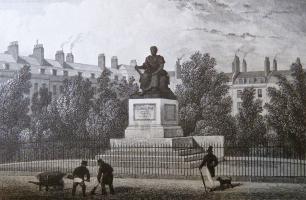
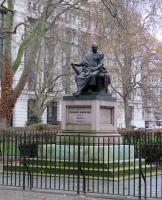
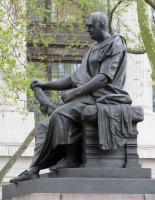
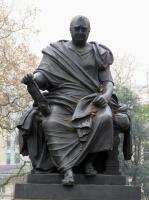
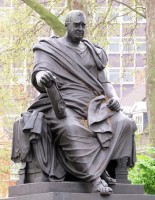
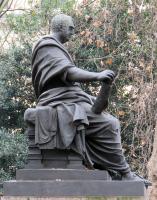
Charles J. Fox statue by Sir Richard Westmacott, RA: different views, and Shepherd's early 19th Century depiction.
Charles J. Fox statue by Sir Richard Westmacott, RA: different views, and Shepherd's early 19th Century depiction.





Bloomsbury Square was the earliest of the various squares in the area, laid out in 1660, though none of the buildings survive from this time. The central grounds were laid out by Humphrey Repton in 1800, and James Burton, builder to the Duke of Bedford, emplaced terraced houses at the same period, which remain to the north side of the Square. The grand bronze statue to the north side of the Square dates from slightly later, being put up in 1816. It is of the statesman Charles J. Fox, and the sculptor was Sir Richard Westmacott RA, most eminent of the Westmacott dynasty of sculptors. Fox is shown Roman senator style, seated on a classical bench, wrapped in a great cloak over a short tunic, dignified and magisterial. One hand is on his lap, the other clasps a wound up scroll of parchment with a prominent seal. His hair is tightly curled to his head, his face heavy, his arms muscular. Though he is seated, one sandalled foot is forward and down on a lower step than the other, giving a sense that he will rise to speak when ready. A noble civic statue. We may note that Westmacott shows a bust in high relief of Fox as part of the monument to James Percy in Wimbledon Parish Church.
Residences of Thomas H. Wyatt and John Nash, architects, Great Russell Street.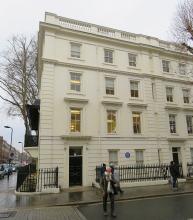
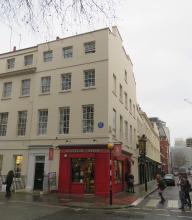
The statue of Fox faces onto Great Russell Street; turning left brings the visitor to the British Museum of course, whose pediment sculpture, also by Sir Richard Westmacott RA, is shown on this page. We may note that before we get to the British Museum, just a few yards along the road, to the right, on the north side of Great Russell Street, is the house of the notable architect Thomas Henry Wyatt, of the dynasty that included as well as a number of other architects, the sculptors Matthew Cotes Wyatt and Richard J. Wyatt. On the south side is the first terrace, and a dwelling place, of the even more notable architect John Nash. Further along Great Russell Street, past the British Museum, lived Charles Dickens at one time, also marked with a blue plaque.
Victoria Friendly Society building, and pediment by H. W. Palliser.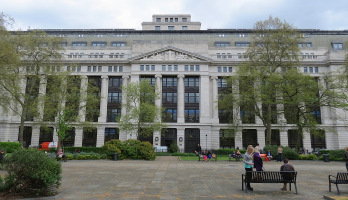

Detail of sculpture by H. W. Palliser; 2nd example from Southampton row pediment.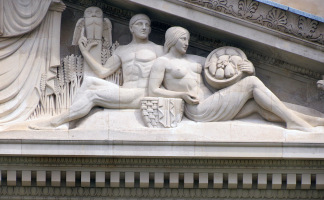
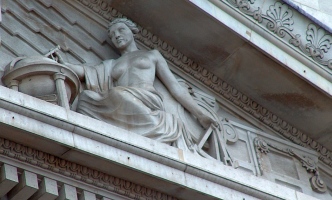
The Square today is rather open, dominated on the East side by a great, broad building from the Deco period. This is the Victoria Building, put up for the Victoria Friendly Society in 1928, the work of the architect William Long. It retains an austere classicism, with giant Ionic pilasters at first floor level stretching up a further three storeys, and of interest for these pages, supporting in the centre a great pediment with sculpted figures. A central standing woman holds out her arms benevolently, her wide cloak falling symmetrically behind her, symbolic of the protective Society. On each side are a pair of seated figures, each consisting of a nude male and semi-nude female. They are symmetrically disposed, but with different accoutrements. To the left side, the woman carries a rich harvest of grapes and a luscious pear, while the man has a Roman-style standard bearing a wreath of oak leave. To the right, the woman carries a whole basket of fruit, and the man gestures to a pillar behind with an owl, symbol of wisdom, on top. On both sides, the background is filled with ripe corn. All this suggestive of the ripening returns from deposits in the Society of course. The narrow corners of the pediment are occupied by a sheep and a goat. The sculpture is very much of its time, with deco-style figures. Thus the male figures have stylised anatomy, formal poses where even though the legs are sideways, the upper torso is angled almost entirely towards the viewer, and the hair is close-cropped. The female figures are somewhat muscular with simple, harmoniously repeating folds to the drapes. The sculptor of this rather excellent work, all too poorly known, is H. W. Palliser, a prolific sculptor of the time. We may note that there is another pediment on the opposite side of the building, to Southampton Row, but the height above the road is such that we can view it only at an angle which makes it hard to appreciate the sculpture: it contains just three figures – a central nude man, and flanking single reclining figures, male and female, with machinery, thus illustrative of Progress. (More pediment sculpture on this page.)
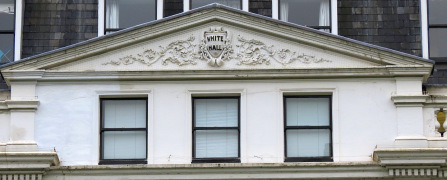
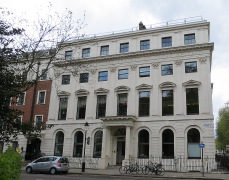 Pediment of White Hall, and Nash-fronted Royal Pharmaceutical Society.
Pediment of White Hall, and Nash-fronted Royal Pharmaceutical Society.
On the other side of the Square, to the west, there are a row of nobly proportioned buildings, four storeys tall with additional attics. The centremost one of these, nine bays wide, has a narrow pediment with light-hearted swirls of acanthus leaves and a central shield with the name of the building, White Hall; the date is 1911. A panel on the building to the left, with little cherubs, indicates the house of Isaac Disraeli, author and father of the great Prime Minister. The right hand or north corner of that side of the Square contains a pilastered classical building, No. 17 Bloomsbury Square, still bearing the title of The Pharmaceutical Society of Great Britain. It is notable as containing an 18th Century core, so Pevsner tells us, made over by John Nash towards the end of the 18th Century; the little portico is Victorian. Alas, no sculpture.
College of Preceptors, with five portrait heads, 1887.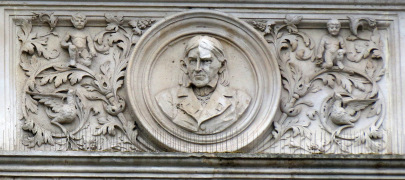
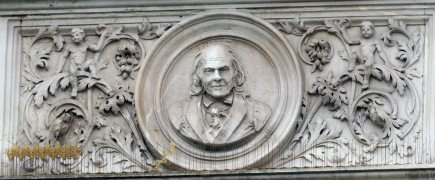
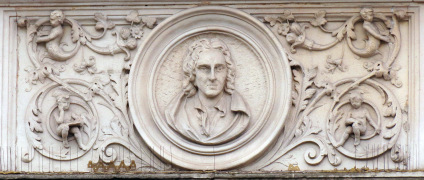
However we do have one further building with sculptural interest, facing onto the Square from the south side at the western side. This is the former College of Preceptors building, dating from 1887, by the obscure architect Frederick Pinches. Mostly in pale stone, with a bit of red brick, among a variety of minor sculptural adornment are five roundels containing portrait heads; these include John Locke, and apparently are all of educationalists. Note too the little grotesque half-figures and putti in the surrounding panels. Above the door is a protruding bay window, supported by a curved corbel-like structure containing a grotesque face among light garlands and hangings. The shield at the top has the motto ‘Pro Doctrinis et Disciplinis’.
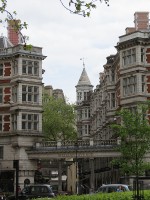
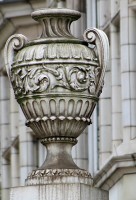
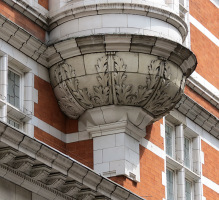 Sicilian Avenue, and example pot and corbel.
Sicilian Avenue, and example pot and corbel.
Finally, in the south-east corner of the Square can be seen the entrance to Sicilian Avenue, a short diagonal cut through to Southampton Row, conceived as an Italian Renaissance pedestrianised shopping street of small boutiques. Two slender, fluted Ionic pillars supporting a balustrade across each end, there is a pretty little circular tower with a pointed roof bearing a weather vane at the south end, and many other nice details. The architect was R. J. Worley, the date 1910.
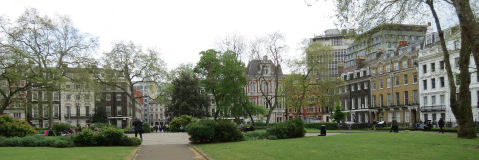 View southwards from Bloomsbury Square.
View southwards from Bloomsbury Square.
North to Gordon Square // Or to Tavistock Square // Or North and East to Queen Square
South-East to Kingsway // And South-West to Oxford Street
Visits to this page from 13 Mar 2014: 9,208